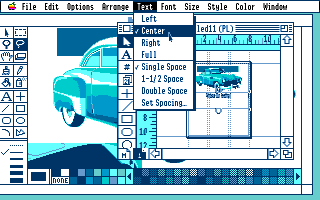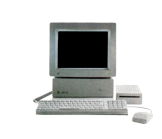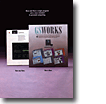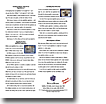Appleworks GS
Your Rating: Not Yet Rated
Average Rating: 4.3 (23 people have rated this item.)
RAM Requirement: 1.25 meg RAM
Release Status: Abandonware
Year: 1988
Publisher: Claris Corporation
Developers: Jeff Erickson, Kevin Harvey, Robert Hearn, Michael Hibbetts, Tom Hoke, Scott Holdaway, John Kinder, Scott Lindsey, Ian Mitchell, Syd Polk, Stephan Schwirzke & Kevin Watts
System 6 Compatible: Yes
Hard Drive Installable: Yes
 Download 2image Archive (1598k)
Download 2image Archive (1598k)
 Download the manual in PDF format (17177k)
Download the manual in PDF format (17177k)
All ebay results related to this archive:
Vntge 88/89 Appleworks GS (AWGS) v1.0 & v1.1 Apple IIGS 3-1/2" Complete -Working
1989 A+ Magazine (Apple II): AppleWorks GS/Roger Rabbit/Wordbench/Apple in Space
Appleworks GS Manual CLARIS Apple Computer Rare Users Guide Vintage 1988 lot
Appleworks GS Manual CLARIS Apple Computer Rare User's Guide Vintage 1988 Manual
Large Lot of Apple II Software & Games ~Appleworks GS, Pac-Man, Alf, +MORE 1980s
Current Apple IIGS related Auctions Listed By Time Left:
Vintage Software Apple II IIe IIc IIgs RUSSIA The Great War in the East
LEGO TC Logo - Super Rare DACTA - APPLE IIe & IIgs - Interface Card & Cable 9767
Apple ADB Touchpad Mouse Mice Replacement for G5431 m1042 M2706 A9M0331 IIGS IIe
Phonics Prime Time 1.0 by MECC for Apple II+, Apple IIe, Apple IIc, Apple IIGS
Sound Tracks 1.0 by MECC for Apple II+, Apple IIe, Apple IIc, Apple IIGS

Appleworks GS was to be the killer application for the platform and was highly anticipated when first shown at AppleFest in May of 1988.
The program was originally developed at Styleware, creators of Multiscribe (a word processor for both the 8-bit Apple II and IIGS specific version) and Top Draw (an object orientated drawing program). During development, Styleware began advertising the program in popular Apple II journals such as A+ and InCider.
Such was the importance of the development of this program for the IIGS that Claris, a spin off company from Apple that developed the original Appleworks and was also responsible for key Mac applications (MacPaint, MacDraw, MacWrite, etc), stepped in and bought Styleware outright and its employees ended up moving to Claris' offices. Bob Hearn, one of the developers of Top Draw and Appleworks GS recounts those days from his perspective.
Appleworks GS continued the tradition of the original 8-bit Appleworks - it was an integrated application including word processing, spreadsheet and database creation. Improving on the original, the GS version also included painting, layout and telecommunications modules, all available from the one application, all available using the standardised Apple interface. This was in the day when no true integrated productivity applications were yet available for the Mac, including Microsoft Office, which were individual applications that needed to be loaded separately.
And the response? Appleworks GS' most common complaint upon its release was its performance - functional, but undeniably slow. So while it was more user friendly than classic Appleworks, its performance was such that many users simply kept using the original, which ran super quick on a IIGS and because of the program's smaller memory requirements it left a lot of free memory to accomodate those large word processor documents, databases and spreadsheets.
The program was buggy, and incompatible with System 5 upon its release in 1989; so minor bug fix releases arrived and brought the program to version 1.1...and there it stayed forever more. For a program that cost $300 U.S., Claris' lack of support was less than overwhelming, contributing to the general ill-feeling towards Apple Computer, who were seen not to be doing nearly enough to support development of programs like AppleWorks GS.
There were plans to update Appleworks GS, but not from inside Claris. Quality Computers had successfully bought the rights to the original Appleworks, and had successfully updated it to versions 4 and 5 and wanted to do the same with Appleworks GS, adding more features to the software and making best possible use out of System 6. However, due to complications with the source code and the time required to get anything out of it, the update could not be completed. Gareth Jones has written about the subject extensively.





